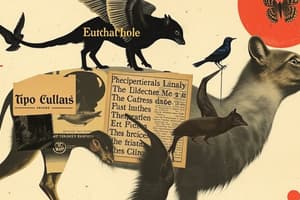Podcast
Questions and Answers
What is a common feature of baby animals mentioned in the text?
What is a common feature of baby animals mentioned in the text?
- They primarily serve as sources of camouflage
- They are often born or hatched as vulnerable and dependent beings (correct)
- They have distinct fur patterns from adult animals
- They rarely receive parental care
What is the purpose of fur patterns mentioned in the text?
What is the purpose of fur patterns mentioned in the text?
- To signal their role in reproduction
- To indicate an animal's fitness, status, or mood (correct)
- To mimic the environment for camouflage
- To help them learn essential skills like hunting and navigation
What is a unique behavior of baby animals mentioned in the text?
What is a unique behavior of baby animals mentioned in the text?
- Resting for long periods of time
- Playful swimming behaviors of baby seals (correct)
- Aggressive territorial behavior
- Complete independence from their parents
How do animals typically benefit from fur patterns according to the text?
How do animals typically benefit from fur patterns according to the text?
Why do many humans feel a deep connection with baby animals according to the text?
Why do many humans feel a deep connection with baby animals according to the text?
What is the purpose of animals forming social groups?
What is the purpose of animals forming social groups?
Which animal forms large herds during annual migration as a safety measure against predators?
Which animal forms large herds during annual migration as a safety measure against predators?
What is the role of the meerkat sentinel group within the collective?
What is the role of the meerkat sentinel group within the collective?
Which animal forms matriarchies led by wise, experienced females?
Which animal forms matriarchies led by wise, experienced females?
How have humans been inspired by the behavior of animals forming groups?
How have humans been inspired by the behavior of animals forming groups?
Flashcards are hidden until you start studying
Study Notes
Animals: A Dynamic World of Groups, Babies, and Fur Patterns
Animals, the diverse kingdom that shares our planet, are an endless source of intrigue, wonder, and education. In this article, we will delve into three fascinating subtopics: groups of animals, baby animals, and the dazzling variety of fur patterns found among them.
Groups of Animals: The Magic of Collectives
One of the most striking features of the animal kingdom is the way that individual animals band together to create powerful, cohesive groups. These collectives, called social groups, herds, or packs, offer incredible benefits to their members.
- Benefits of Group Living: Survival advantages include protection from predators, improved foraging, and increased opportunities for mating. For instance, wildebeest form large herds with up to 2 million members during their annual migration, providing safety in numbers against predators like lions and hyenas.
- Types of Collectives: Examples range from meerkat sentinel groups where one member stays alert for danger, to elephant matriarchies in which a wise, experienced female leads a family group.
- Human-Animal Interactions: Humans have long observed animals forming groups and have even used their behavior as inspiration for their own societies. For example, military units often employ tactics inspired by the coordinated movements of birds in flight.
Baby Animals: The Joy of New Life
The arrival of baby animals is always a cause for celebration and wonder. These young creatures are typically born or hatched into the world as vulnerable and dependent beings, with much to learn from their parents.
- Varied Development: From the tiny, fragile eggs of birds to the live births of mammals, animals have evolved many different methods of reproduction and development.
- Parental Care: Parents often invest significant time and energy in caring for their young, teaching them essential skills like hunting and navigation. For example, lionesses protect their cubs fiercely and teach them to hunt cooperatively.
- Baby Animal Behavior: Baby animals have unique behaviors that are often distinct from their adult counterparts, such as the playful swimming behaviors of baby seals or the curious exploration of baby elephants.
- Human-Animal Connection: Many humans are deeply enamored with baby animals, often keeping them as pets or studying them in the wild. Their endearing behavior and uncanny resemblance to human infants can spark a profound sense of connection.
Fur Patterns: The Art of Camouflage and Display
The stunning variety of fur patterns found among animals is as diverse as the animals themselves. These patterns serve numerous purposes, from camouflage to display, and can offer valuable insights into the lives of these creatures.
- Camouflage: Fur patterns can help animals blend into their environment, making it more difficult for predators to spot them. For example, a snow leopard's spotted fur pattern allows it to blend into the rocky terrain of the Himalayas.
- Display: Fur patterns can also signal an animal's fitness, status, or mood. For instance, the bright colors of a male flamingo's feathers indicate he is in good health and ready to mate.
- Pattern Differences: Fur patterns can also vary depending on the sex of the animal, with males and females often sporting different patterns to signal their role in reproduction.
- Human-Animal Connection: The intricacy and beauty of fur patterns have long captivated humans, who have studied them extensively and used them as inspiration for art, fashion, and design.
In conclusion, the animal kingdom is a place of endless fascination and wonder, where complex social groups, baby animals, and stunning fur patterns all play essential roles. By exploring these subtopics, we can deepen our appreciation for the natural world and gain a greater understanding of the animals that share our planet.
Studying That Suits You
Use AI to generate personalized quizzes and flashcards to suit your learning preferences.





